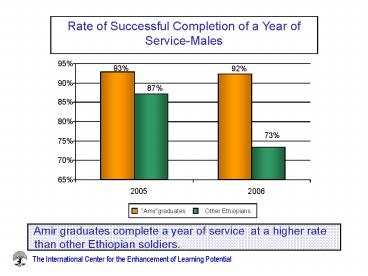Rate of Successful Completion of a Year of ServiceMales - PowerPoint PPT Presentation
1 / 14
Title:
Rate of Successful Completion of a Year of ServiceMales
Description:
Amir graduates complete a year of service at a higher rate than other Ethiopian soldiers. ... Other Ethiopians. Rate of Successful Completion of a Year of ... – PowerPoint PPT presentation
Number of Views:22
Avg rating:3.0/5.0
Title: Rate of Successful Completion of a Year of ServiceMales
1
Rate of Successful Completion of a Year of
Service-Males
Amirgraduates
Other Ethiopians
Amir graduates complete a year of service at a
higher rate than other Ethiopian soldiers.
2
Rate of Successful Completion of a Year of
Service-Females
100
100
97
94
95
90
85
85
80
75
2005
2006
Amir graduates complete a year of service at a
higher rate than other Ethiopian soldiers.
3
Professional category placement-males
- Majority of Amir graduates are placed in quality
category courses. - Rate of admin. placement compared to other
Ethiopians. - Officer combat categories-rare placements.
- 40-50 of other Ethiopians are placed in combat
units. - 2007- partial placements to date.
4
Professional category placement-females
- Majority of Amir graduates are placed in quality
category courses. - Rate of admin. placement compared to other
Ethiopians. - Officer combat categories-rare placements.
- 40-50 of other Ethiopians are placed in combat
units. - 2007- partial placements to date.
5
Professional category placement - males
Amir graduates complete a year of service in the
same professional category at a higher rate than
other Ethiopian soldiers.
6
Professional category placement-females
Amir graduates complete a year of service in the
same professional category at a higher rate than
other Ethiopian soldiers.
7
Incarceration rates - males
Lower incarceration rate among Amir graduates,
decrease in 2006.
8
Incarceration rates - females
Lower incarceration rate among Amir graduates,
decrease in 2006.
9
Desertion rates-males
Lower desertion rates among Amir graduates as
opposed to other Ethiopian soldiers.
10
Desertion rates-females
Lower desertion rates among Amir graduates as
opposed to other Ethiopian soldiers.
11
AWOL Rates - Males
Lower AWOL rates among Amir graduates as opposed
to other Ethiopian soldiers.
12
AWOL Rates - Females
Lower AWOL rates among Amir graduates as opposed
to other Ethiopian soldiers.
13
Updated Research Findings
- During the last 3 Amir courses participants were
given questionnaires on self competence, self
esteem, coping with pressure and social support. - The questionnaires were administered at the
beginning the end of the course. - In all courses, a distinct improvement was seen
on all questionnaires between the first
measurement and the last.
14
Improvement on the Dapar Test Amir 9
- The graph shows a decrease in the percentage of
10-20 grades between the first and second
measurement, a decrease in 30-40 grades and a
decrease in 50-60 grades probably due to an
increase in the percentage of grades in the 70s. - There was also a distinct difference between
Dapar means on the first and second measurements.
Second measurement Dapar grades mean was higher
than that of the first measurement (34.63 SD
14.67 as opposed to 38.53 SD 14.41).































